E. coli – Sprouts
A total of 51 people infected with the outbreak strain of E. coli O103 were reported from 10 states.
Illnesses started on dates ranging from January 6, 2020, to March 15, 2020. Ill people ranged in age from 1 to 79 years, with a median age of 29 years. Fifty-five percent of ill people were female. Of 41 ill people with information available, 3 were hospitalized and no deaths were reported.
Epidemiologic, traceback, and laboratory evidence indicated that clover sprouts were the source of this outbreak.
In interviews, ill people answered questions about the foods they ate and other exposures they had in the week before their illness started. Eighteen (56%) of 32 people interviewed reported eating sprouts. This percentage is significantly higher than results from a survey of healthy people in which 8% reported eating sprouts in the week before they were interviewed.
Seventeen (63%) of 27 people interviewed reported eating sprouts at a Jimmy John’s restaurant. Jimmy John’s LLC reported that all of their restaurants stopped serving clover sprouts on February 24, 2020. Clover sprouts are no longer available at Jimmy John’s restaurants.
Additionally, FDA identified the outbreak strain of E. coli O103 in samples of Chicago Indoor Garden products that contain sprouts. On March 16, 2020, Chicago Indoor Garden recalled all products containing red clover sprouts.
FDA’s traceback investigation showed that a common seed lot was used to grow both the sprouts recalled by Chicago Indoor Garden and sprouts that were served at some Jimmy John’s locations. The same seed lot was also used to grow sprouts linked to an outbreak of the same strain of E. coli O103 infections in 2019.
 E. coli – Unknown
E. coli – Unknown
As of December 16, 2020, a total of 32 people infected with the outbreak strain of E. coli O157:H7 were reported from 12 states.
Illnesses started on dates ranging from June 6, 2020, to October 25, 2020. Ill people ranged in age from 2 to 75 years, with a median age of 27 years, and 72% were female. Of 29 ill people with information available, 15 were hospitalized and 1 developed hemolytic uremic syndrome (HUS), a type of kidney failure. One death was reported from Michigan.
State and local public health officials interviewed ill people to determine what they ate and other exposures in the week before they got sick. Ill people reported eating a variety of food items. Several ill people also reported eating at the same restaurant and had eaten multiple common food items. CDC analyzed the interview data and did not identify a specific food item as a potential source of the outbreak. FDA conducted traceback investigations for several of the food items served at the restaurant and did not find a common source in the distribution chain.
 E. coli – Leafy Greens
E. coli – Leafy Greens
As of December 18, 2020, a total of 40 people infected with the outbreak strain of E. coli O157:H7 were reported from 19 states.
Illnesses started on dates ranging from August 10, 2020, to October 31, 2020. Ill people ranged in age from 1 to 85 years, with a median age of 33 years, and 60% were female. Of 34 ill people with information available, 20 people were hospitalized and 4 people developed hemolytic uremic syndrome (HUS), a type of kidney failure. No deaths were reported.
Epidemiologic and traceback evidence showed that leafy greens were the likely source of this outbreak. Investigators were unable to identify a specific type or brand of leafy greens because people in this outbreak reported eating a variety of leafy greens and because different leafy greens are often grown, harvested, and processed together.
State and local public health officials interviewed ill people to determine what they ate and other exposures in the week before they got sick. Of the 23 ill people interviewed, 22 reported eating or maybe eating a variety of leafy greens, including spinach (16) and romaine lettuce (15).
FDA completed traceback investigations for several types of leafy greens ill people reported eating. Several farms of interest were identified, but no single ranch was a common source of the leafy greens.
FDA and state partners conducted inspections on farms of interest and collected environmental samples. FDA is analyzing the samples and continuing their investigations to identify the root cause of this outbreak.
 E. coli – Leafy Greens
E. coli – Leafy Greens
As of December 16, 2020, a total of 18 people infected with the outbreak strain of E. coli O157:H7 were reported from nine states.
Illnesses started on dates ranging from September 2, 2020, to November 6, 2020. Ill people ranged in age from 8 to 71 years, with a median age of 28 years, and 72% were female. Of 16 ill people with information available, 6 were hospitalized. No deaths were reported.
State and local public health officials interviewed ill people to determine what they ate and other exposures in the week before they got sick. Of the 13 people interviewed, all reported eating or maybe eating various types of leafy greens, including romaine lettuce (9), spinach (9), and iceberg lettuce (7).
Laboratory testing identified the outbreak strain in a sample of Tanimura & Antle romaine lettuce in a single-head package, which was recalled on November 6, 2020. However, investigators were unable to determine if any ill people in this outbreak got sick from eating the recalled product. No one specifically reported eating Tanimura & Antle romaine lettuce, and some people got sick before the “packed on” dates for the recalled products.
FDA conducted traceback investigations and worked with state partners to conduct inspections at several farms. However, none of the findings identified a common source in the distribution chain or linked the farms to the outbreak.